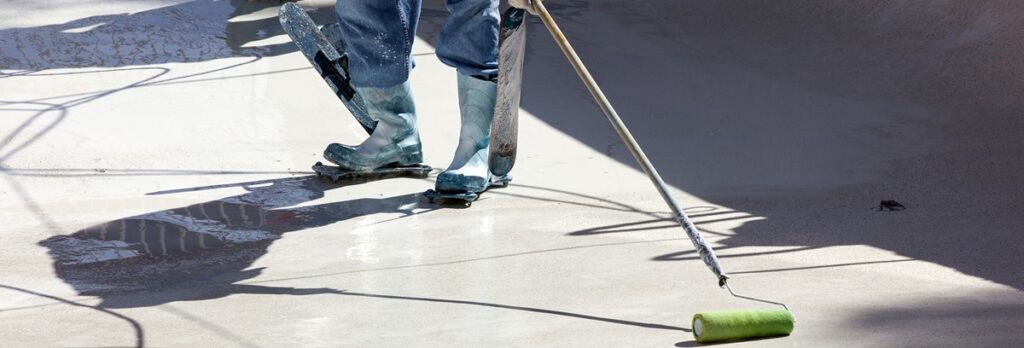Pool Resurfacing and Surface Repair

Swimming pools are an essential part of many Arizona homes. But like anything that gets regular use, pools wear out over time. Resurfacing and repairing a pool is no small task; it’s a crucial process that requires careful planning and professional expertise.
The resurfacing and repair of a pool is more than just a facelift. It enhances the pool’s durability, appearance, and overall value. In fact, according to industry statistics, a well-resurfaced pool can increase the value of your property by up to 7%.
Revive Your Pool to Perfection: Contact Living Water Pool Co for Top-notch Repair and Service in Arizona!
Request a Free Quote Today!
Click the button below to be connected to our pool professionals that are here to answer all of your questions.
Understanding Pool Resurfacing: What It Is and Why It’s Necessary
Resurfacing is the process of removing the damaged surface layer and replacing it with fresh, new material. It’s not just about aesthetics; it’s vital for maintaining the pool’s structural integrity. Cracks and other defects can lead to leaks, compromising the pool’s foundation and causing more significant issues later.Types of Pool Surface Materials: A Comprehensive Guide
The material chosen for resurfacing plays a significant role in the look and feel of the pool. It also impacts the cost and durability.
Here’s a glance at the most popular materials used in pool resurfacing:
- Plaster: Classic and cost-effective, plaster provides a smooth finish but requires regular maintenance.
- Fiberglass: Known for its strength and flexibility, fiberglass is more resistant to cracks and stains.
- Pebble Tec: Offering a natural appearance, Pebble Tec is a blend of cement and small pebbles, known for its long-lasting beauty.
The Living Water Pool Company experts can guide you through the options and help you select the one that fits your needs and budget. Our experience in the Arizona climate ensures that we recommend materials that can withstand the local conditions.
The Pool Resurfacing Process: Step-by-Step Guide
Resurfacing a pool isn’t a weekend DIY project. It’s a multi-step process that requires precision, knowledge, and the right tools. At Living Water Pool Company, we’ve mastered the process to ensure a seamless experience.
- Draining the Pool: First and foremost, the pool is drained, and the old surface is prepared for removal.
- Removing the Old Surface: The worn-out layer is stripped away with care and precision, revealing the substrate beneath.
- Preparing the Substrate: This involves smoothing and repairing defects in the underlying structure to ensure a flawless finish.
- Applying the New Surface: The chosen resurfacing material is meticulously applied, guaranteeing an even and attractive appearance.
- Finishing Touches: The pool is carefully inspected, and the final touches, including resealing and filling, are completed.
Pool Surface Repair: Identifying Common Problems and Solutions
Sometimes, a pool may not need complete resurfacing but rather targeted repairs. Common problems include cracks, chips, and discoloration, which can degrade the pool’s appearance and functionality.
- Cracks can occur due to ground movement, temperature changes, or age. Small cracks can often be patched, while larger ones may necessitate more extensive repairs.
- Discoloration: Factors like chemicals, minerals, and algae can cause staining. Treatment with specialized chemicals or a light acid wash can resolve these issues.
- Chips and Surface Wear: Rough usage and weather conditions can wear down the pool’s surface over time. Targeted repairs and resurfacing of specific areas can bring it back to life.
Full Resurfacing vs. Partial Resurfacing: What’s Best for Your Pool?
The decision between full and partial resurfacing depends on various factors, including the pool’s age, the extent of the damage, and your budget. Full resurfacing transforms the entire pool, giving it a brand-new look, while partial resurfacing targets specific problem areas.
- Full Resurfacing: Ideal for older pools with extensive wear, full resurfacing offers a comprehensive renewal of the pool’s appearance and function.
- Partial Resurfacing: Perfect for relatively newer pools with localized damage, partial resurfacing can provide a fresh look without the cost of a full overhaul.
Our team at Living Water can provide a detailed inspection to determine the best course of action for your pool. We offer transparent and honest advice, prioritizing your satisfaction and the longevity of your investment.
Maintenance After Resurfacing: How to Extend the Life of Your Pool Surface
Regular maintenance is key to extending the lifespan of your pool surface after resurfacing. One important aspect of maintenance is regular cleaning. This involves removing any debris or leaves that can accumulate on the surface and brushing the walls and bottom of the pool to prevent algae and build-up from occurring. It is also important to ensure you use the proper tools and equipment to clean your pool.
Additionally, it is crucial to monitor the water chemistry regularly. This includes testing the pH levels, as well as the chlorine and alkalinity levels, and making adjustments as necessary. By maintaining proper water chemistry, you can prevent the growth of harmful bacteria and ensure the surface of your pool remains in good condition.
Furthermore, regular inspections are essential for identifying potential issues or damage. By inspecting the pool surface and equipment, you can promptly address any necessary repairs or maintenance tasks. Neglecting necessary repairs can lead to further damage and more costly repairs.
